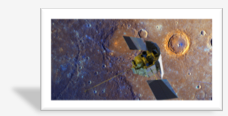
Link to the NES Virtual Campus home page.

Link to the NES Virtual Campus home page.
 In this final NASA Now program of the 2011-2012 school year, Katie Presson of the Payload Operations Integration team at NASA’s Marshall Space Flight Center, discusses investigations being conducted on the ISS. She describes the detailed process of getting science investigations, or payloads, approved and ready for their journey to the ISS. Presson also discusses safety requirements and describes some unique experiments for education and how teachers and students can be involved.
In this final NASA Now program of the 2011-2012 school year, Katie Presson of the Payload Operations Integration team at NASA’s Marshall Space Flight Center, discusses investigations being conducted on the ISS. She describes the detailed process of getting science investigations, or payloads, approved and ready for their journey to the ISS. Presson also discusses safety requirements and describes some unique experiments for education and how teachers and students can be involved.
 NASA’s educator guide How High Is It? includes mathematics activities to explain scale size and scale distance. The guide helps put aside misconceptions about how far away spacecraft and satellites are. At 22,240 miles above Earth, spacecraft put into orbit over the equator travel at 7,000 miles per hour around the equator and follow Earth’s rotation.
NASA’s educator guide How High Is It? includes mathematics activities to explain scale size and scale distance. The guide helps put aside misconceptions about how far away spacecraft and satellites are. At 22,240 miles above Earth, spacecraft put into orbit over the equator travel at 7,000 miles per hour around the equator and follow Earth’s rotation.
Link to the NES Virtual Campus home page.
 The 50th anniversary of America’s first manned spaceflight is being commemorated with the issuance of two stamps. The stamps went on sale May 4, 2011.
The 50th anniversary of America’s first manned spaceflight is being commemorated with the issuance of two stamps. The stamps went on sale May 4, 2011. NASA’s educator guide How High Is It? includes mathematics activities to explain scale size and scale distance. The guide helps put aside misconceptions about how far away spacecraft and satellites are. At 22,240 miles above Earth, spacecraft put into orbit over the equator travel at 7,000 miles per hour around the equator and follow Earth’s rotation.
NASA’s educator guide How High Is It? includes mathematics activities to explain scale size and scale distance. The guide helps put aside misconceptions about how far away spacecraft and satellites are. At 22,240 miles above Earth, spacecraft put into orbit over the equator travel at 7,000 miles per hour around the equator and follow Earth’s rotation. A lunar eclipse occurs when the moon passes behind Earth so that Earth blocks the sun’s rays from striking the moon. This can occur only when the sun, Earth and moon are aligned exactly, or very closely, with Earth in the middle. Hence, there is always a full moon the night of a lunar eclipse.
A lunar eclipse occurs when the moon passes behind Earth so that Earth blocks the sun’s rays from striking the moon. This can occur only when the sun, Earth and moon are aligned exactly, or very closely, with Earth in the middle. Hence, there is always a full moon the night of a lunar eclipse.Unlike a solar eclipse, which can only be viewed in a relatively small area on Earth, a lunar eclipse can be seen by anyone on the night side of Earth. A lunar eclipse lasts for a few hours, whereas a total solar eclipse lasts for only a few minutes at any given place. Some lunar eclipses have been associated with important historical events.
Link to the NES Virtual Campus home page.
 Dr. David Le Vine, deputy principal investigator for the Aquarius mission, discusses why we need to know more about sea surface salinity. Le Vine is an expert in measurement physics at NASA’s Goddard Space Flight Center. He is currently a scientist with the Aquarius mission, which gathers data on sea surface salinity. Our current knowledge of sea surface salinity is very limited because in the past we’ve only collected data from ships traveling in shipping lanes.
Dr. David Le Vine, deputy principal investigator for the Aquarius mission, discusses why we need to know more about sea surface salinity. Le Vine is an expert in measurement physics at NASA’s Goddard Space Flight Center. He is currently a scientist with the Aquarius mission, which gathers data on sea surface salinity. Our current knowledge of sea surface salinity is very limited because in the past we’ve only collected data from ships traveling in shipping lanes.The Aquarius satellite will scan the entire surface of Earth once every seven days for three years collecting data on sea surface salinity. Analysis of these data will help to better predict climate conditions.
Link to the NES Virtual Campus home page.
NASA Now Minute: Aquarius
 People in many countries throughout the world use satellite images and data. It’s important to be able to determine the exact time a picture was taken or data collected. To meet this need, satellites use a time stamp standard for tagging images and data — Universal Time, referred to as UT; or Zulu Time, designated by the letter Z; or Greenwich Mean Time, abbreviated as GMT. All three designations refer to the same time. The recorded time is the time at the 0º line of longitude, which runs through Greenwich, England.
People in many countries throughout the world use satellite images and data. It’s important to be able to determine the exact time a picture was taken or data collected. To meet this need, satellites use a time stamp standard for tagging images and data — Universal Time, referred to as UT; or Zulu Time, designated by the letter Z; or Greenwich Mean Time, abbreviated as GMT. All three designations refer to the same time. The recorded time is the time at the 0º line of longitude, which runs through Greenwich, England.Link to the NES Virtual Campus home page.
 NASA will host a news conference at 1 p.m. EDT on Thursday, June 16, to reveal new images and science findings from the first spacecraft to orbit Mercury. The event will be held in the NASA Headquarters. NASA Television and the agency’s website will broadcast the event.
NASA will host a news conference at 1 p.m. EDT on Thursday, June 16, to reveal new images and science findings from the first spacecraft to orbit Mercury. The event will be held in the NASA Headquarters. NASA Television and the agency’s website will broadcast the event.Link to the NES Virtual Campus home page.